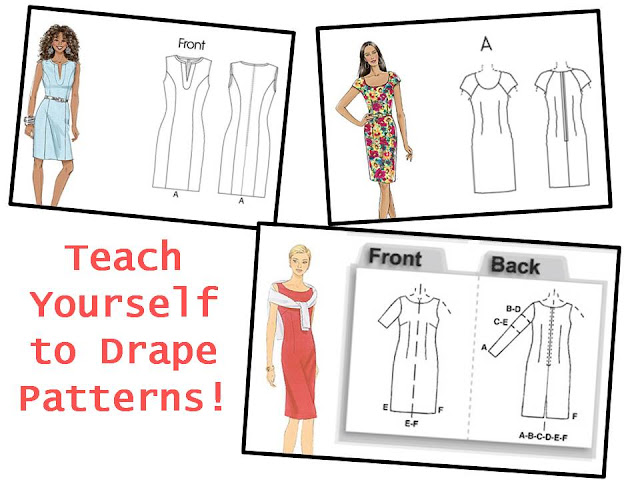
Let's Talk About: Fashion Design
When you have fashion design ideas, one of the first skills you need to have is creating an original pattern. If you cannot take a pattern design class, it can be very frustrating to learn how to make a pattern. There are two main ways to produce a pattern. The draping method uses a professional dress form, laying fabric on it to create the desired garment style. The flat drafting method uses measurements to create a drafted pattern. Often the draft is actually a manipulation of a pre-existing pattern.
Most students begin with pattern draping. After learning to work with fabric on the 3-D form, their pattern can be traced onto paper and used for future patterns. The following information will be based on learning how to drape patterns.
Before you start: the first purchase must be a dress form. While these can be costly, they are essential for all types of design and sewing, so it is as important to own as your sewing machine. What size to buy? If you plan to create designs that might later be sold, you should consider a sample size "8" to start. This is generally considered a basic size. If you have a specific target market, get your dress form in their 'average' size and shape. If you are sewing for yourself, then that size would be best. If you are looking at an older dress form, brands such as "Modern Model" and "Wolf" are common. "PGM" is a more recent brand that is imported.
Professional dress forms will have the following:
strong, sturdy base with wheels and adjustable height pedal
collapsable shoulders (used to pull off skirts)
princess seam lines in the muslin cover
shoulder plates where the armholes should be
pin-able surface
Tools and Supplies for Pattern Draping:
Pins: long pins are best for working on a dress form
L ruler, aluminum:: 24" x 14", this is a metal ruler with a right angle
Clear ruler: this "C through" 18" long x 2" wide ruler has a grid mapped on it.
Measuring tape: plastic
Marker: many students use 'sharpie' brand markers
Pencil: a standard desk type pencil can be used
tailor's chalk: a chalk that is thin and flat for sharp lines
Shears: you will want 8" sharp fabric shears for cutting your yardage
Muslin: 100% cotton is required. A medium weight is best (don't use a thin, cheap muslin)
Twill tape: 1/4" wide tape will be used to wrap around the dress form to mark specific body areas
Tools and Supplies for transfering muslin pattern to paper:
tracing wheel or pattern wheel: sharp needle point wheel with wooden handle
awl: to punch holes in the paper
French curve: clear plastic curve to draft smooth lines around curves
hip curve: 24" long, a larger gentle curve used to draft smooth lines
pattern notcher: 1/16", used to mark pattern edges
dot paper
manila paper or other heavy paper such as 'butcher paper'
heavy scissors: for cutting paper
Tutorials for learning Pattern Draping:
Before starting a draping program, the student should have a good understanding of sewing and some experience working with patterns. Before beginning a drape, it would be a good idea to purchase the same style pattern first, then cut and sew it before learning to drape it.
A series of tutorials for 10 garment processes along with how to prepare the dress form is available online through Cornell University, HERE. Each process is shown in a step-by-step format. The entire set of tutorials equals about one or two semesters of classroom projects at the college level. A draping text is recommended as a guide. This series assumes the student is an intermediate level sewist, who has experience in sewing the garment being draped.
Videos: With so many videos available online, it's tough to select tutorials that are well planned and accurate.
Craftsy.com has a full series of pattern draping tutorials taught by Paul Gallo. They are well priced, and appear to be comprehensive enough to get a student started in the draping technique. On youtube.com this short video on draping by PandemicApparel is also a good place to start if you don't want to spend a cent before you get a 'feel' for this process:
References: You can never have too many good books. These are typical titles used in fashion draping courses:
Draping Basics, by Sally Di Marco. I recommend this first due to the great tutorial photos. She works with gingham fabric, which clearly show the grainlines while working. There is a pdf preview online: HERE
The Art of Fashion Draping, by Connie Amaden-Crawford
Draping for Apparel Design, by Helen Joseph-Armstrong
Draping for Fashion Design, by Hilde Jaffe
Shopping Resources: Most tools and supplies can be found online if you aren't located near a fashion college's student store. One popular vendor is IDS International Design Supplies, Inc., Los Angeles and student kits are available: HERE
I hope this helps you to get started learning pattern design. If you have any questions--just ask and I'll get back with an answer!
This original article on fashion is part 10 of a series called "Let's Talk About:" that is posted only here at Pintucks. The contents of this article are the intellectual property of this blog. Please do not copy any content or images to another blog or digital media without contacting me first. I will ask that you link back to this article and give reference to this source within your feature. If you are using content or images for a research paper or project, please link back to this page in the traditional academic format, thank you!
